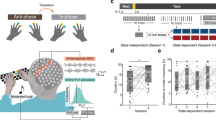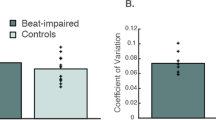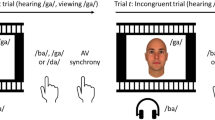Abstract
Rhythmic bimanual movements are highly constrained in the temporal domain, with the gestures of the two hands tightly synchronized. Previous studies have implicated a subcortical locus for temporal coupling based on the observation that these constraints persist in callosotomy patients. We now report that such coupling is restricted to movements entailing a discrete event (such as a movement onset). Three callosotomy patients exhibited a striking lack of temporal coupling during continuous movements, with the two hands oscillating at non-identical frequencies. We propose a subcortical locus of temporal coupling for movements involving discrete events. In contrast, synchronization between the hands during continuous movements depends on interhemispheric transmission across the corpus callosum.
This is a preview of subscription content, access via your institution
Access options
Subscribe to this journal
Receive 12 print issues and online access
$209.00 per year
only $17.42 per issue
Buy this article
- Purchase on Springer Link
- Instant access to full article PDF
Prices may be subject to local taxes which are calculated during checkout






Similar content being viewed by others
References
Kelso, J. S., Southard, D. L. & Goodman, D. On the coordination of two-handed movements. J. Exp. Psychol. Hum. Percept. Perform. 5, 229–238 (1979).
Marteniuk, R. G., MacKenzie, C. L. & Baba, D. M. Bimanual movement control: information processing and interaction effects. Q. J. Exp. Psychol. A. 36, 335–365 (1984).
Kelso, S. J. A., Putnam, C. A. & Goodman, D. On the space-time structure of human interlimb co-ordination. Q. J. Exp. Psychol. A. 35, 347–375 (1983).
Franz, E. A. Spatial coupling in the coordination of complex actions. Q. J. Exp. Psychol. A. 50, 684–704 (1997).
Franz, E. A., Zelaznik, H. N. & McCabe, G. Spatial topological constraints in a bimanual task. Acta Psychol. 77, 137–151 (1991).
Franz, E. A., Eliassen, J. C., Ivry, R. B. & Gazzaniga, M. S. Dissociation of spatial and temporal coupling in the bimanual movements of callosotomy patients. Psychol. Sci. 7, 306–310 (1996).
Eliassen, J. C., Baynes, K. & Gazzaniga, M. S. Direction information coordinated via the posterior third of the corpus callosum during bimanual movements. Exp. Brain. Res. 128, 573–577 (1999).
Ivry, R. B. & Hazeltine, E. Subcortical locus of temporal coupling in the bimanual movements of a callosotomy patient. Hum. Mov. Sci. 18, 345–375 (1999).
Preilowski, B. F. Possible contribution of the anterior forebrain commissures to bilateral motor coordination. Neuropsychologia 10, 267–277 (1972).
Tuller, B. & Kelso, J. A. Environmentally specified patterns of movement coordination in normal and split-brain subjects. Exp. Brain. Res. 75, 306–316 (1989).
Zaidel, D. & Sperry, R. W. Some long-term motor effects of cerebral commissurotomy in man. Neuropsychologia 15, 193–204 (1977).
Robertson, S. D. et al. Correlations for timing consistency among tapping and drawing tasks: evidence against a single timing process for motor control. J. Exp. Psychol. Hum. Percept. Perform. 25, 1316–1330 (1999).
Carson, R. G., Thomas, J., Summers, J. J., Walters, M. R. & Semjen, A. The dynamics of bimanual circle drawing. Q. J. Exp. Psychol. A. 50, 664–683 (1997).
Semjen, A., Summers, J. J. & Cattaert, D. Hand coordination in bimanual circle drawing. J. Exp. Psychol. Hum. Percept. Perform. 21, 1139–1157 (1995).
Kelso, J. A. S. Dynamic Patterns: the Self-organization of Brain and Behaviour (MIT Press, Cambridge, Massachusetts, 1995).
Cattaert, D., Semjen, A. & Summers, J. J. Simulating a neural cross-talk model for between-hand interference during bimanual circle-drawing. Biol. Cybern. 81, 343–358 (1999).
Georgopoulos, A. P., Schwartz, A. B. & Kettner, R. E. Neuronal population coding of movement direction. Science 233, 1416–1419 (1986).
Hollerbach, J. M. An oscillation theory of handwriting. Biol. Cybern. 42, 139–156 (1981).
Ivry, R. B., Franz, E. A., Kingstone, A. & Johnston, J. C. The psychological refractory period effect following callosotomy: uncoupling of lateralized response codes. J. Exp. Psychol. Hum. Percept. Perform. 24, 463–480 (1998).
Kalaska, J. F., Scott, S. H., Cisek, P. & Sergio, L. E. Cortical control of reaching movements. Curr. Opin. Neurobiol. 7, 849–859 (1997).
Kakei, S., Hoffman, D. S. & Strick, P. L. Muscle and movement representations in the primary motor cortex. Science 285, 2136–2139 (1999).
Porter, R. & Lemon, R. Corticospinal Function and Voluntary Movement (Oxford Univ. Press, 1993).
Serrien, D. J., Nirkko, A. C., Lovblad, K. O. & Wiesendanger, M. Damage to the parietal lobe impairs bimanual coordination. Neuroreport 12, 2721–2724 (2001).
Eliassen, J. C., Baynes, K. & Gazzaniga, M. S. Anterior and posterior callosal contributions to simulataneous bimanual movements of the hand and fingers. Brain 123, 2501–2511 (2000).
Zelaznik, H. N., Spencer, R. M. & Doffin, J. G. Temporal precision in tapping and circle drawing movements at preferred rates is not correlated: further evidence against timing as a general-purpose ability. J. Motor Behav. 32, 193–199 (2000).
Bullock, D. & Grossberg, S. Neural dynamics of planned arm movements: emergent invariants and speed-accuracy properties during trajectory formation. Psychol. Rev. 95, 49–90 (1988).
Ivry, R. B. & Richardson, T. Temporal control and coordination: the multiple timer model. Brain Cogn. (in press).
Verschueren, S. M., Swinnen, S. P., Cordo, P. J. & Dounskaia, N. V. Proprioceptive control of multijoint movement: bimanual circle drawing. Exp. Brain. Res. 127, 182–192 (1999).
Sidtis, J. J., Volpe, B. T., Wilson, D. H., Rayport, M. & Gazzaniga, M. S. Variability in right hemisphere language function after callosal section: evidence for a continuum of generative capacity. J. Neurosci. 1, 323–331 (1981).
Gazzaniga, M. S., Holtzman, J. D., Deck, M. D. & Lee, B. C. MRI assessment of human callosal surgery with neuropsychological correlates. Neurology 35, 1763–1766 (1985).
Corballis, P. M., Inati, S., Funnell, M. G., Grafton, S. T. & Gazzaniga, M. S. MRI assessment of spared fibers following callosotomy: a second look. Neurology 57, 1345–1346 (2001).
Fisher, N. I. Statistical Analysis of Circular Data (Cambridge Univ. Press, 1993).
Acknowledgements
This work was supported by NIH grants P50 NS17778 and R01 NS30256. The authors are grateful to Noam Sobel, Bekki Spencer and Howard Zelaznik for their comments on this manuscript and to Paul Corballis for his assistance with the data collection.
Author information
Authors and Affiliations
Corresponding author
Ethics declarations
Competing interests
The authors declare no competing financial interests.
Rights and permissions
About this article
Cite this article
Kennerley, S., Diedrichsen, J., Hazeltine, E. et al. Callosotomy patients exhibit temporal uncoupling during continuous bimanual movements. Nat Neurosci 5, 376–381 (2002). https://doi.org/10.1038/nn822
Received:
Accepted:
Published:
Issue Date:
DOI: https://doi.org/10.1038/nn822
This article is cited by
-
The effect of elastic and viscous force fields on bimanual coordination
Experimental Brain Research (2023)
-
Impact of interhemispheric inhibition on bimanual movement control in young and old
Experimental Brain Research (2022)
-
The modulation of short and long-latency interhemispheric inhibition during bimanually coordinated movements
Experimental Brain Research (2021)
-
Repeated Vowel Production Affects Features of Neural Activity in Sensorimotor Cortex
Brain Topography (2019)
-
On the assessment of coordination between upper extremities: towards a common language between rehabilitation engineers, clinicians and neuroscientists
Journal of NeuroEngineering and Rehabilitation (2016)



